Workplace threats—like unauthorized access, tailgating, vandalism, and forced entry—are a constant concern for organizations. No matter how prepared you are, there’s always a chance that an unexpected attack or emergency could seriously impact your business. To make matters worse, advancements in technology are actually creating more challenges for security teams. According to Splunk’s State of Security 2024 report, 77% of organizations believe Generative AI will make it even more challenging to defend against external threats.
It’s obvious that the scope of securing the workplace has expanded over the past decade. It’s no longer just about protecting employees from physical or financial harm—it’s also about tackling digital security risks like cyberattacks and protecting your onsite employees during natural disasters. To help, here’s a list of common workplace threats to plan for today and in the future.
1. Natural disaster or extreme weather
Natural disasters don’t spare workplaces when they strike. While these events are impossible to control or predict, you can take steps to protect employees and visitors. Establishing an emergency preparedness plan—that includes an automated process for instantly notifying all impacted individuals—can make all the difference when rapid response matters.
{{protip-1}}
2. Theft of physical or intellectual property
The most plain security threats may be those to a company’s physical and intellectual property. This can include anything from patents and employee know-how to trade secrets, laptops, and physical documents.
A visitor management system (VMS) can help by making it easier for your staff to control who has access to sensitive areas in your workplace. These solutions should enable you to screen visitors against internal blocklists, third-party watchlists, and other databases to keep workplace threats out. If your business uses a physical access control system, a VMS can integrate seamlessly with it, allowing you to manage who has access to where from one centralized dashboard.
{{protip-3}}
3. Workplace incidents
Not creating a secure workplace can leave your business open to legal action from your employees if they injure themselves while onsite. Workplace incidents include things like accidents at work, bullying, or verbal and physical harassment. Left unchecked, these incidents can lead to even more severe consequences over time.
Regulations around employee safety and violence prevention are becoming stricter in many states. In California, for instance, Senate Bill 553 (SB 553) now requires employers with physical workspaces to implement workplace violence prevention plans, or face fines starting at $18,000 per violation.
{{protip-2}}
4. Cyberattacks
Cyberattacks are on the rise. And while preventing cyberattacks isn’t impossible, it does take effort. Companies need to identify their cybersecurity vulnerabilities to reduce the chance of an attack. These risks could include privilege abuse, mishandling data, using unapproved hardware or software, or email misuse.
Raising employee awareness is also key to preventing cyber threats. Phishing attacks account for more than 80% of reported security incidents. They can be difficult to spot. For example, an employee might receive an eerily realistic-looking email from someone claiming to be your CEO, asking for money or sensitive information. Training employees on how to recognize and respond to these threats can make them more cautious and aware
5. IT failure of a business-critical system
Hardware and software failures, accidental damage, network issues, or other critical IT problems can cause lasting damage to your business. At the very least, they’re costly, time-consuming, and difficult to fix. While you can’t predict every IT failure, you can take steps to reduce the impact.
Regularly assessing your systems for vulnerabilities is a great way to identify potential weak spots before they become issues. It’s also important to make sure your IT team has the right tools, training, and resources to respond quickly and learn from any failures.
6. Health threats
Health threats are still very prevalent, especially in the workplace. According to research by Duke University, disease outbreaks will likely grow three-fold in the next few decades. Companies must prepare for these situations by having business continuity plans and mitigation strategies in place. To do that, you should invest in the tools that automate and standardize the enforcement of health protocols.
7. Utility outage
Utility outages can range from hazardous at worst to inconvenient at best. In today’s connected workplaces, they can disrupt communication between employees, customers, and partners. The good news? With the right preparation and training, many utility outages can be prevented.
Consider establishing a clear outage response plan and running regular drills to ensure teams know how to act. This reduces downtime and boosts staff confidence during disruptions.
8. Supply chain disruption
Who hasn’t heard of the supply chain disruption? Everyone is aware of the issues during the pandemic, but there are other potential risks coming down the road. Businesses have identified climate change-induced flooding, geopolitical instability, and forced labor regulations are among the things that could cause major disruptions in 2025. Supply chain issues aren’t going away anytime soon. That’s why companies and their leaders need to conduct regular supply chain vulnerability assessments and establish a risk-management plan of action.
9. Brand and reputation crises
Brand reputation directly ties to a company’s market value. What may take years to grow can tarnish overnight. Nowadays, it can be a single social media post that takes a company down. Risks can come from any part of the business, including unethical suppliers, partners, and employees—even competition. Communicating to your employees the do’s and don’ts, particularly on social media, can help mitigate some of these risks.
-
Prevention and mitigation planning are both important to effectively minimize disruptions from workplace threats. Organizations need to be able to identify emerging problems before they become full-blown threats. Doing so also helps minimize damage caused by a workplace threat.
—
Learn how to ensure everyone is informed during a critical situation in Envoy’s ultimate guide to emergency notifications.
Key insight: Emergency notification solutions can allow you to send out customizable messages via the channels your employees already use, like Microsoft Teams and Slack. These alerts can provide timely and critical information, such as evacuation routes, lockdown instructions, or weather updates.
Pro tip: How do you stop an incident from happening? Start by implementing a standardized visitor policy that enables you to manage and track visitor access. If you're in the market for a visitor management solution, prioritize those that allow you to send out pre-registration communication, automatically log visitor details, and integrate with your other workplace tools.

We partnered with Hanover Research to survey business leaders on the biggest workplace trends shaping 2025.
Here’s a snapshot of what we found:
- 65% have increased their year-over-year workplace budgets.
- Only 49% of leaders are measuring how their workspaces are being used.
- 73% say Gen Z will drive companies toward more flexible work models.

Read more
Searching for a visitor management solution? Learn what to look out for and how to choose the best tech for your team.
Managing your space well doesn’t have to be difficult. But if you want to be successful, you need the right approach.
A well-run workplace can set your team up for success. Learn why workplace management matters and how to do it right.
Workplace security is critical to the future of your business. Learn why it matters, what threats to watch for, and how to strengthen your workplace security plan.
In this post, we’ll explore what workplace compliance is and how to build a compliance culture for your organization.
With more folks sending personal packages to the workplace, having a sound mailroom management system in place is key.









